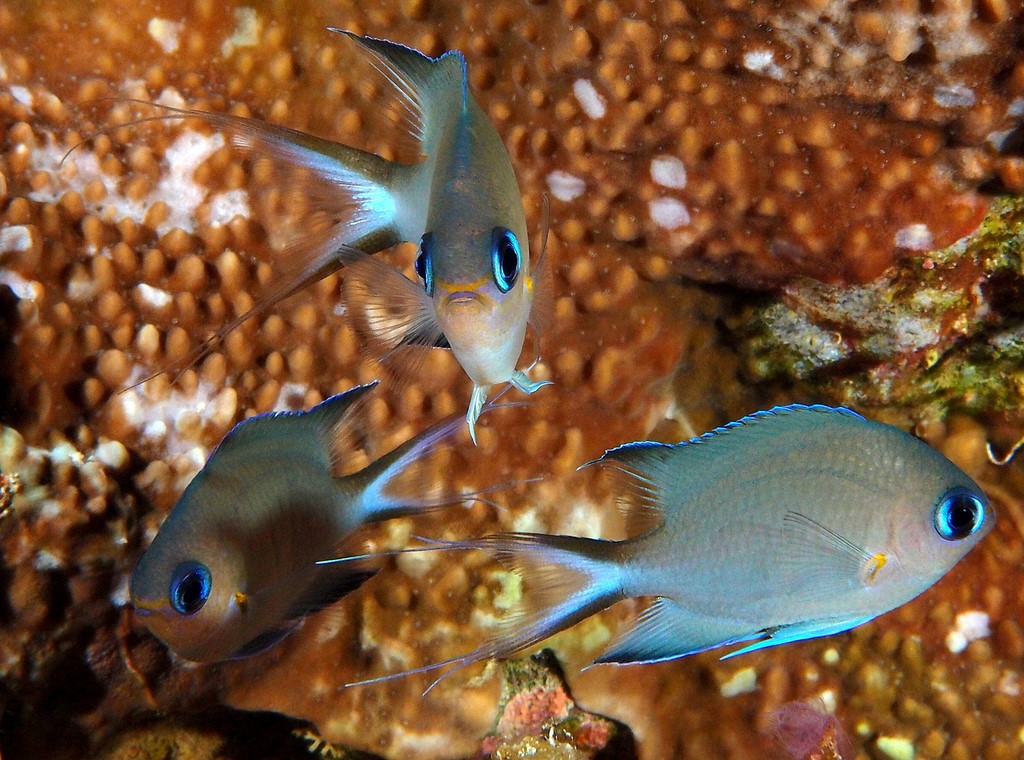PYCNOCHROMIS AMBOINENSIS - (BLEEKER, 1871)
Actinopterygii (Gigaclass) > Actinopteri (Class) > Teleostei (Subclass) > Blenniiformes (Order) > Pomacentridae (Family) > Chrominae (Subfamily) > Pycnochromis (Genus)
Chromis d'Ambon, Ambon chromis, Ambon puller, Anbon suzumedai, アンボンスズメダイ, 安汶光鰓魚, 安汶光鳃鱼,
Synonymes
Abudefduf bimaculatus (MacLeay, 1883)
Chromis amboiensis (Bleeker, 1871)
Chromis amboinensis (Bleeker, 1871)
Chromis fragoris (Whitley, 1964)
Gliphidodon bimaculatus (MacLeay, 1883)
Glyphidodon bimaculatus (MacLeay, 1883)
Heliases amboinensis (Bleeker, 1871)
---------------------------------
Description
Dorsal spines (total): 12; Dorsal soft rays (total): 12-13; Anal spines: 2; Anal soft rays: 12-13; Pectoral fin rays: 16-17; Lateral line scales: 13-14; Gill rakers: 26-29; Body depth: 1.5-1.7 in Standard Length; A relatively deep-bodied with elongate dorsal. Tips of caudal fin-lobes ending in two filaments. Max. length: 10.0 cm SL. Depth range: 5 - 70 m.
Color
Light brown generally, becoming very pale to whitish below, edges of scales very obscurely darker. Iris brownish. Infraorbital gray white. Dorsals and anals deep brown terminally, last rays of soft dorsal and soft anal abruptly whitish. Caudal with upper and lower edges broadly duslcy, medianly whitish. Upper and lower edges of caudal peduncle slightly darker brown than sides. Paired fins pale brownish. Pectoral sometimes with faint brown shade or blotch basally, axil pale. Ventral dusky terminally, front edge narrowly whitish.
Etymology
Pycnochromis: from ancient Greek, puknós = dense, compact, thick. Referring to “very smooth” head of Pycnochromis vanderbilti, the “edges of the suborbitals, preopercle and opercle little distinct” + from chromis: from Greek, chroemo = to neigh. A name dating to Aristotle, referring to a drum (Sciaenidae) and its ability to make noise; Later applied to this damselfish and subsequently expanded to embrace dottybacks, cichlids and wrasses (all perch-like fishes once thought to be related).
amboinensis: named for Ambon Island. Ambon Island is part of the Maluku Islands of Indonesia.
Original description: Heliases amboinensis Bleeker, 1871 - Type locality: Ambon Island, Molucca Islands, Indonesia.
Distribution
Eastern Indian Ocean, western Pacific: Christmas Islands and Cocos-Keeling islands east to Micronesia and Papua New Guinea, north to Yaeyama Islands (Japan), south to Western Australia, Queensland (Australia) and New Caledonia.
Biology
Adults inhabit coral-rich areas of clear lagoon and seaward reefs. Abundant on steep outer reef slopes, uncommon in lagoons. Juveniles in large branching corals, adults mainly in caves. Found in aggregations. Oviparous, distinct pairing during breeding. Forms pair during the breeding season. Females lay demersal adhesive eggs that are guarded and aerated by the male parent until the larvae hatch. Feeds on zooplankton. Aquarium fish.
Similar species
Chromis d'Ambon, Ambon chromis, Ambon puller, Anbon suzumedai, アンボンスズメダイ, 安汶光鰓魚, 安汶光鳃鱼,
Synonymes
Abudefduf bimaculatus (MacLeay, 1883)
Chromis amboiensis (Bleeker, 1871)
Chromis amboinensis (Bleeker, 1871)
Chromis fragoris (Whitley, 1964)
Gliphidodon bimaculatus (MacLeay, 1883)
Glyphidodon bimaculatus (MacLeay, 1883)
Heliases amboinensis (Bleeker, 1871)
---------------------------------
Description
Dorsal spines (total): 12; Dorsal soft rays (total): 12-13; Anal spines: 2; Anal soft rays: 12-13; Pectoral fin rays: 16-17; Lateral line scales: 13-14; Gill rakers: 26-29; Body depth: 1.5-1.7 in Standard Length; A relatively deep-bodied with elongate dorsal. Tips of caudal fin-lobes ending in two filaments. Max. length: 10.0 cm SL. Depth range: 5 - 70 m.
Color
Light brown generally, becoming very pale to whitish below, edges of scales very obscurely darker. Iris brownish. Infraorbital gray white. Dorsals and anals deep brown terminally, last rays of soft dorsal and soft anal abruptly whitish. Caudal with upper and lower edges broadly duslcy, medianly whitish. Upper and lower edges of caudal peduncle slightly darker brown than sides. Paired fins pale brownish. Pectoral sometimes with faint brown shade or blotch basally, axil pale. Ventral dusky terminally, front edge narrowly whitish.
Etymology
Pycnochromis: from ancient Greek, puknós = dense, compact, thick. Referring to “very smooth” head of Pycnochromis vanderbilti, the “edges of the suborbitals, preopercle and opercle little distinct” + from chromis: from Greek, chroemo = to neigh. A name dating to Aristotle, referring to a drum (Sciaenidae) and its ability to make noise; Later applied to this damselfish and subsequently expanded to embrace dottybacks, cichlids and wrasses (all perch-like fishes once thought to be related).
amboinensis: named for Ambon Island. Ambon Island is part of the Maluku Islands of Indonesia.
Original description: Heliases amboinensis Bleeker, 1871 - Type locality: Ambon Island, Molucca Islands, Indonesia.
Distribution
Eastern Indian Ocean, western Pacific: Christmas Islands and Cocos-Keeling islands east to Micronesia and Papua New Guinea, north to Yaeyama Islands (Japan), south to Western Australia, Queensland (Australia) and New Caledonia.
Biology
Adults inhabit coral-rich areas of clear lagoon and seaward reefs. Abundant on steep outer reef slopes, uncommon in lagoons. Juveniles in large branching corals, adults mainly in caves. Found in aggregations. Oviparous, distinct pairing during breeding. Forms pair during the breeding season. Females lay demersal adhesive eggs that are guarded and aerated by the male parent until the larvae hatch. Feeds on zooplankton. Aquarium fish.
Similar species
- Acanthochromis polyacanthus (Bleeker, 1855) - Reported from New Caledonia - Link to the species (here). Best distinguished by 17 dorsal spines, highest number in the family. This fish has a number of color variants, and ranges from whitish to all brown or dark grey, sometimes with a white tail.
- Azurina lepidolepis (Bleeker, 1877) - Reported from New Caledonia - Link to the species (here).
- Chromis ternatensis (Bleeker, 1856) - Reported from New Caledonia - Link to the species (here).
Last update: 16, September 2021
